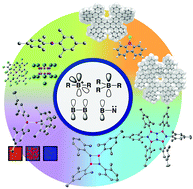Bringing out the potential of organoboron compounds by designing the chemical bonds and spaces around boron
Abstract
Since the structures, reactivity and properties of organoboron compounds stem from the electron deficiency and low electronegativity of boron, the design of the chemical bonds attached to boron as well as the space provided by substituents around boron leads to particular reactivity and functions of organoboron compounds. Based on the concept of vacant boron p-orbital engineering in combination with peripheral space design for boron, we have developed new organoboron compounds, which exhibit exotic reactivity and properties and boron-mediated organic transformations capable of constructing large π-conjugated systems. Here we describe our recent study by focusing on three topics: (i) the synthesis and its derivatization, small-molecule activation and application to materials science of a two-coordinate boron cation (borinium ion), (ii) a 9-borafluorene-mediated benzannulation reaction of alkyne derivatives and (iii) BN-substituted molecules featuring a 4nπ heterocycle exhibiting unique electronic and emission properties. The molecules and reactions appearing in this article are unprecedented, yet feature very simple systems, and therefore clearly demonstrate intrinsic and new potential of organoboron compounds.

- This article is part of the themed collection: Boron Chemistry in the 21st Century: From Synthetic Curiosities to Functional Molecules


 Please wait while we load your content...
Please wait while we load your content...